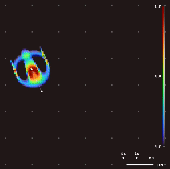

Lenia is a family of
cellular automata
A cellular automaton (pl. cellular automata, abbrev. CA) is a discrete model of computation studied in automata theory. Cellular automata are also called cellular spaces, tessellation automata, homogeneous structures, cellular structures, tessel ...
created by Bert Wang-Chak Chan.
It is intended to be a
continuous
Continuity or continuous may refer to:
Mathematics
* Continuity (mathematics), the opposing concept to discreteness; common examples include
** Continuous probability distribution or random variable in probability and statistics
** Continuous g ...
generalization of
Conway's Game of Life
The Game of Life, also known simply as Life, is a cellular automaton devised by the British mathematician John Horton Conway in 1970. It is a zero-player game, meaning that its evolution is determined by its initial state, requiring no furt ...
, with
continuous states,
space and time Space and Time or Time and Space, or ''variation'', may refer to:
* '' Space and time'' or ''time and space'' or ''spacetime'', any mathematical model that combines space and time into a single interwoven continuum
* Philosophy of space and time
S ...
. As a consequence of its continuous, high-resolution domain, the complex autonomous patterns ("lifeforms" or "
spaceships") generated in Lenia are described as differing from those appearing in other cellular automata, being "geometric,
metameric
In biology, metamerism is the phenomenon of having a linear series of body segments fundamentally similar in structure, though not all such structures are entirely alike in any single life form because some of them perform special functions.
In ...
, fuzzy, resilient, adaptive, and rule-generic".
Lenia won the 2018 Virtual Creatures Contest at the
Genetic and Evolutionary Computation Conference
The Genetic and Evolutionary Computation Conference (GECCO) is the premier conference in the area of genetic and evolutionary computation. GECCO has been held every year since 1999, when it was first established as a recombination of the Internat ...
in Kyoto, an honorable mention for the ALIFE Art Award at ALIFE 2018 in Tokyo, and Outstanding Publication of 2019 by the International Society for Artificial Life (ISAL).
Rules
Iterative updates
Let
be the ''lattice'' or ''grid'' containing a set of states
. Like many cellular automata, Lenia is updated iteratively; each output state is a
pure function
In computer programming, a pure function is a function that has the following properties:
# the function return values are identical for identical arguments (no variation with local static variables, non-local variables, mutable reference arg ...
of the previous state, such that
where
is the initial state and
is the ''global rule'', representing the application of the ''local rule'' over every site
. Thus
.
If the simulation is advanced by
at each timestep, then the time resolution
.
State sets
Let
with maximum
. This is the ''state set'' of the automaton and characterizes the possible states that may be found at each site. Larger
correspond to higher ''state resolutions'' in the simulation. Many cellular automata use the lowest possible state resolution, i.e.
. Lenia allows for much higher resolutions. Note that the actual value at each site is not in

 Lenia is a family of
Lenia is a family of  Lenia is a family of
Lenia is a family of